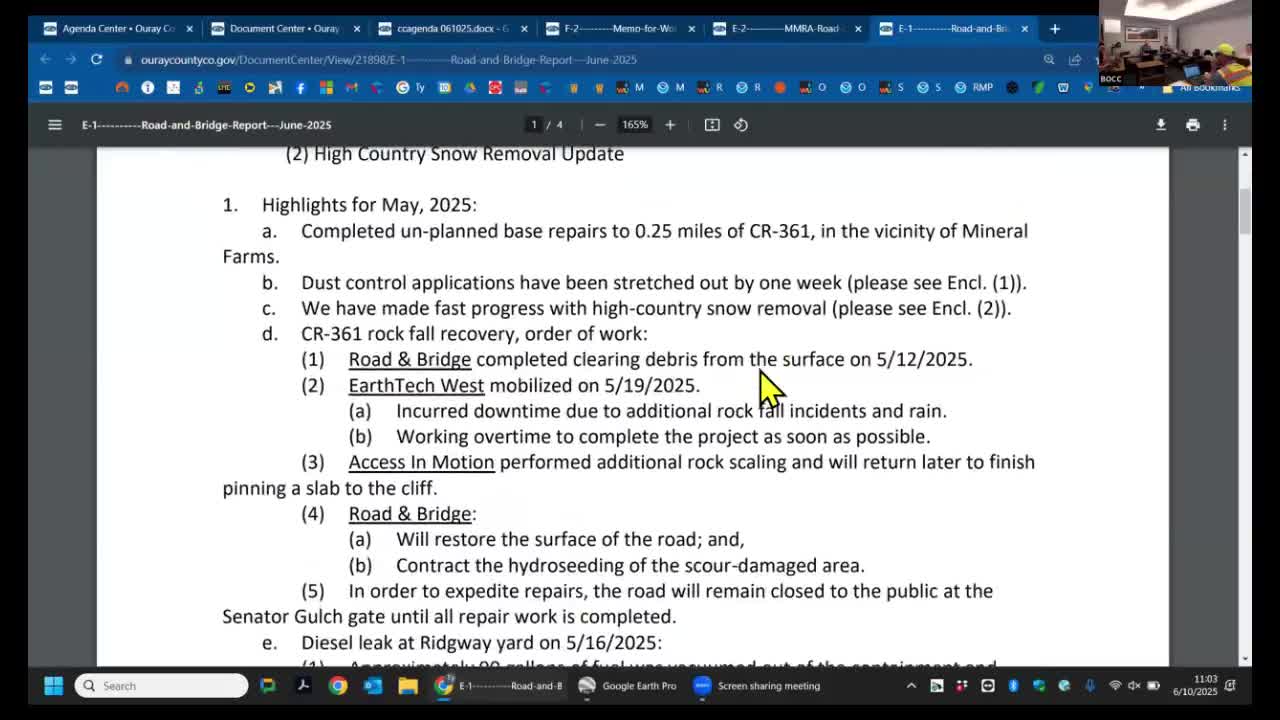County officials approve $9,300 hydroseeding plan for scoured area near Mineral Farms
June 10, 2025 | Ouray County, Colorado
This article was created by AI summarizing key points discussed. AI makes mistakes, so for full details and context, please refer to the video of the full meeting. Please report any errors so we can fix them. Report an error »

During the Ouray County Board of County Commissioners (BOCC) regular meeting on June 10, 2025, significant discussions centered around road repairs and environmental restoration efforts following recent geological disturbances. The meeting highlighted the county's proactive approach to infrastructure maintenance and environmental stewardship, particularly in the wake of damage caused by rockfalls.
One of the primary topics was the completion of unplanned repairs on County Road 361, which had suffered from sagging and poor compaction. The repairs, which took a week to complete, set the county back on its dust control schedule by about a week. The area, known for its deep fill material, required immediate attention to ensure safety and accessibility.
Additionally, the meeting addressed ongoing rockfall recovery efforts. The contractor, EarthTech West, faced delays due to additional rockfall events and adverse weather conditions. Despite these challenges, the county anticipates reopening the road to public access soon. The urgency of these repairs is underscored by the need for safe travel routes in the region, which is vital for both residents and visitors.
A key point of discussion was the need for revegetation in areas affected by soil disturbance during the rockfall mitigation efforts. The county's Road and Bridge department proposed a hydroseeding project to restore vegetation on approximately one acre of scoured land, which is primarily on private property. The estimated cost for this project is around $9,300. The commissioners expressed their support for the initiative, recognizing the importance of mitigating erosion and restoring the landscape.
The proposed hydroseeding plan includes a specialized seed mix and application techniques tailored for the steep, rocky terrain. This approach aims to enhance the chances of successful vegetation growth, addressing both environmental concerns and the expectations of the affected property owner, Dr. Gephardt, who has been cooperative throughout the process.
The discussions also touched on the historical context of rock management in the area, with commissioners emphasizing the need for future maintenance practices to consider vegetation growth. The commitment to revegetate the disturbed area aligns with the county's responsibility to manage environmental impacts effectively.
In conclusion, the Ouray County BOCC meeting underscored the county's dedication to maintaining infrastructure while also prioritizing environmental restoration. The anticipated hydroseeding project reflects a balanced approach to addressing immediate repair needs and long-term ecological health, setting a precedent for future projects in the region. The board's decisions will likely influence how similar situations are handled moving forward, reinforcing the importance of responsible land management in the face of natural challenges.
One of the primary topics was the completion of unplanned repairs on County Road 361, which had suffered from sagging and poor compaction. The repairs, which took a week to complete, set the county back on its dust control schedule by about a week. The area, known for its deep fill material, required immediate attention to ensure safety and accessibility.
Additionally, the meeting addressed ongoing rockfall recovery efforts. The contractor, EarthTech West, faced delays due to additional rockfall events and adverse weather conditions. Despite these challenges, the county anticipates reopening the road to public access soon. The urgency of these repairs is underscored by the need for safe travel routes in the region, which is vital for both residents and visitors.
A key point of discussion was the need for revegetation in areas affected by soil disturbance during the rockfall mitigation efforts. The county's Road and Bridge department proposed a hydroseeding project to restore vegetation on approximately one acre of scoured land, which is primarily on private property. The estimated cost for this project is around $9,300. The commissioners expressed their support for the initiative, recognizing the importance of mitigating erosion and restoring the landscape.
The proposed hydroseeding plan includes a specialized seed mix and application techniques tailored for the steep, rocky terrain. This approach aims to enhance the chances of successful vegetation growth, addressing both environmental concerns and the expectations of the affected property owner, Dr. Gephardt, who has been cooperative throughout the process.
The discussions also touched on the historical context of rock management in the area, with commissioners emphasizing the need for future maintenance practices to consider vegetation growth. The commitment to revegetate the disturbed area aligns with the county's responsibility to manage environmental impacts effectively.
In conclusion, the Ouray County BOCC meeting underscored the county's dedication to maintaining infrastructure while also prioritizing environmental restoration. The anticipated hydroseeding project reflects a balanced approach to addressing immediate repair needs and long-term ecological health, setting a precedent for future projects in the region. The board's decisions will likely influence how similar situations are handled moving forward, reinforcing the importance of responsible land management in the face of natural challenges.
View full meeting
This article is based on a recent meeting—watch the full video and explore the complete transcript for deeper insights into the discussion.
View full meeting
